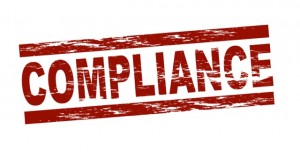Ask anyone involved in business compliance and they’ll tell you they often find themselves somewhere between slightly confused and extremely frustrated. And regardless where they fall on that spectrum, everyone agrees that ensuring a company is in compliance can be very time-consuming. As regulatory requirements for keeping track of documents increase (Sarbanes-Oxley or SOX and the Health Insurance Portability and Accountability Act or HIPAA are just two of the names you’ll frequently hear), there’s more pressure than ever on companies to do a better job of managing their information assets.
 While business compliance requires a comprehensive strategy that involves both processes and tools, an Enterprise Content Management (ECM) system can be, and should be, one of the cornerstones of that strategy. Here are some thoughts to keep in mind as you consider how an ECM solution can help you streamline and simplify your compliance process.
While business compliance requires a comprehensive strategy that involves both processes and tools, an Enterprise Content Management (ECM) system can be, and should be, one of the cornerstones of that strategy. Here are some thoughts to keep in mind as you consider how an ECM solution can help you streamline and simplify your compliance process.
1. Non-compliance is not an option. As you no doubt know, there are serious legal and financial risks for companies that don’t follow compliance regulations. So, simply “hoping we don’t get audited” is not a good idea.
2. Step 1 is standardization. Before an ECM system can help you stay in compliance, there is plenty of up-front work that must be done. This includes formalizing your business processes and workflows, defining document categories, setting rules for data retention that meet both legal requirements and your operational needs, etc. Be sure everyone involved in your project knows that while an ECM system can help you with business process management, it is not a quick fix for compliance.
3. Tools are only effective when used properly and consistently. An ECM system, while it can provide tremendous compliance-related benefits, is only a tool. In order for it to do its job, the people who use it must understand what it does and why it does it. And they must adhere to the business processes and procedures you’ve put in place. An ECM solution can’t be “certified” as being compliant; only companies are compliant.
4. Not every document is affected by compliance regulations. Although an ECM system gives you the ability to collect, categorize, store, retain, and ultimately dispose of every document your organization creates, that doesn’t mean you have to. And trying to track every single piece of content is both inefficient and ineffective.
5. Industry awareness is imperative. Your ECM system can help you stay in compliance with existing regulations, and the processes and rules it enforces can be easily updated as regulations change, but it’s up to you to stay on top of new or modified directives that affect your industry.
Conclusion
Ultimately, a well-defined, well-maintained Enterprise Content Management system can be a powerful tool in helping ensure your company meets its legal obligations. It can also help those tasked with compliance sleep better at night.
My team and I are a close-knit group comprised of Enterprise Content Management (ECM) experts skilled in design, development, implementation and support. We take a personal interest in every project we tackle and every client we work with. I invite you to follow Buddha Logic’s LinkedIn Company page and our Twitter account or to reach out to us by email.
About the Author
Charles Weidman is the President and CTO of Buddha Logic. Charlie has over two decades of experience in the design, development and implementation of enterprise content management, business process management and enterprise resource planning solutions. He founded Buddha Logic with the idea that well-architected digital document capture and management processes are both beautifully simple and powerfully logical. Find and connect with Charlie on LinkedIn.

